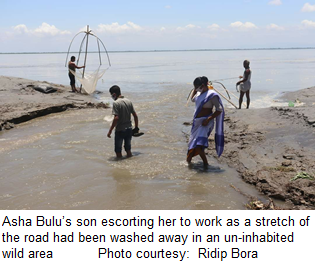 Bulu Bhuyan is an ASHA worker since 2006 in Solmora health subcentre, Block Kamalabari, District Majuli in the state of Assam. The health centre caters to a population of approximately 3000 people residing in Block Kamalabari. During the monsoons,
the entire area gets inundated making it difficult for Bulu to commute but that does not deter her from taking an arduous journey to work.
Bulu Bhuyan is an ASHA worker since 2006 in Solmora health subcentre, Block Kamalabari, District Majuli in the state of Assam. The health centre caters to a population of approximately 3000 people residing in Block Kamalabari. During the monsoons,
the entire area gets inundated making it difficult for Bulu to commute but that does not deter her from taking an arduous journey to work.
As part of the State’s COVID19 response team, I was responsible for monitoring people under home quarantine. There are about 600 households in my assigned area. The houses are located far beyond the embankment and visiting them during the monsoons becomes a herculean task as roads are flooded. It was no different this year. I walked through the highland farms, paddy fields, and small streams. When the entire area was submerged during September, we used boats to travel within our area. We are all physically strong people and can navigate a boat by ourselves. Even when the water level recedes, there is no respite, as the wilted plants and the silt make it even more difficult to walk”, recollected Bulu.
 Community
health workers or ASHAs contribution to dealing with this pandemic is unparalleled. Health workers like Bulu who are at the frontlines braving extreme weather conditions and the risk of infection have contributed significantly in surveillance activities
by conducting door-to-door visits to list out potential cases and linking them with the local health teams for further testing. It has taken months of hard work to bring down the active cases in the state.
Community
health workers or ASHAs contribution to dealing with this pandemic is unparalleled. Health workers like Bulu who are at the frontlines braving extreme weather conditions and the risk of infection have contributed significantly in surveillance activities
by conducting door-to-door visits to list out potential cases and linking them with the local health teams for further testing. It has taken months of hard work to bring down the active cases in the state.
 The state of Assam is finally seeing the light at the end of the tunnel as it reported a significant increase in the recovery rate at 97% and mortality rate at 0.45% as of 11 November 2020. Multi-pronged approaches, including strict quarantine measures,
surveillance, activating a strong primary health care network, strong community engagement, surveillance, and access to testing, tracing and treatment have contributed significantly to better recovery and low mortality rate in the state.
The state of Assam is finally seeing the light at the end of the tunnel as it reported a significant increase in the recovery rate at 97% and mortality rate at 0.45% as of 11 November 2020. Multi-pronged approaches, including strict quarantine measures,
surveillance, activating a strong primary health care network, strong community engagement, surveillance, and access to testing, tracing and treatment have contributed significantly to better recovery and low mortality rate in the state.
